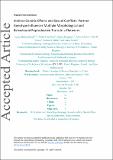Files in this item
Indirect genetic effects and sexual conflicts: partner genotype influences multiple morphological and behavioural reproductive traits in a flatworm
Item metadata
| dc.contributor.author | Marie-Orleach, Lukas | |
| dc.contributor.author | Vogt-Burri, Nadja | |
| dc.contributor.author | Mouginot, Pierick | |
| dc.contributor.author | Schlatter, Aline | |
| dc.contributor.author | Vizoso, Dita | |
| dc.contributor.author | Bailey, Nathan William | |
| dc.contributor.author | Schärer, Lukas | |
| dc.date.accessioned | 2018-03-22T00:33:08Z | |
| dc.date.available | 2018-03-22T00:33:08Z | |
| dc.date.issued | 2017 | |
| dc.identifier | 249668136 | |
| dc.identifier | 514e0473-2980-435f-852a-15bc311bd356 | |
| dc.identifier | 85016623332 | |
| dc.identifier | 000401256200009 | |
| dc.identifier.citation | Marie-Orleach , L , Vogt-Burri , N , Mouginot , P , Schlatter , A , Vizoso , D , Bailey , N W & Schärer , L 2017 , ' Indirect genetic effects and sexual conflicts: partner genotype influences multiple morphological and behavioural reproductive traits in a flatworm ' , Evolution , vol. Early View . https://doi.org/10.1111/evo.13218 | en |
| dc.identifier.issn | 0014-3820 | |
| dc.identifier.other | ORCID: /0000-0003-3531-7756/work/60888403 | |
| dc.identifier.uri | https://hdl.handle.net/10023/12990 | |
| dc.description.abstract | The expression of an individual's phenotypic traits can be influenced by genes expressed in its social partners. Theoretical models predict that such indirect genetic effects (IGEs) on reproductive traits should play an important role in determining the evolutionary outcome of sexual conflict. However, empirical tests of (i) whether reproductive IGEs exist, (ii) how they vary among genotypes, and (iii) whether they are uniform for different types of reproductive traits are largely lacking. We addressed this in a series of experiments in the simultaneously hermaphroditic flatworm Macrostomum lignano. We found strong evidence for IGEs on both morphological and behavioral reproductive traits. Partner genotype had a significant impact on the testis size of focal individuals—varying up to 2.4-fold—suggesting that IGEs could mediate sexual conflicts that target the male sex function. We also found that time to first copulation was affected by a genotype × genotype interaction between mating partners, and that partner genotype affected the propensity to copulate and perform the postcopulatory suck behavior, which may mediate conflicts over the fate of received ejaculate components. These findings provide clear empirical evidence for IGEs on multiple behavioral and morphological reproductive traits, which suggests that the evolutionary dynamics of these traits could be altered by genes contained in the social environment. | |
| dc.format.extent | 14 | |
| dc.format.extent | 1390014 | |
| dc.language.iso | eng | |
| dc.relation.ispartof | Evolution | en |
| dc.subject | G × G interaction | en |
| dc.subject | Interacting phenotype | en |
| dc.subject | Sexual conflicts | en |
| dc.subject | Social effects | en |
| dc.subject | Sperm competition | en |
| dc.subject | testis evolution | en |
| dc.subject | QH301 Biology | en |
| dc.subject | QH426 Genetics | en |
| dc.subject | DAS | en |
| dc.subject.lcc | QH301 | en |
| dc.subject.lcc | QH426 | en |
| dc.title | Indirect genetic effects and sexual conflicts: partner genotype influences multiple morphological and behavioural reproductive traits in a flatworm | en |
| dc.type | Journal article | en |
| dc.contributor.sponsor | NERC | en |
| dc.contributor.institution | University of St Andrews. School of Biology | en |
| dc.contributor.institution | University of St Andrews. Centre for Biological Diversity | en |
| dc.identifier.doi | https://doi.org/10.1111/evo.13218 | |
| dc.description.status | Peer reviewed | en |
| dc.date.embargoedUntil | 2018-03-21 | |
| dc.identifier.grantnumber | NE/L011255/1 | en |
This item appears in the following Collection(s)
Items in the St Andrews Research Repository are protected by copyright, with all rights reserved, unless otherwise indicated.

